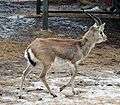Goitered gazelle
| Goitered gazelle | |
|---|---|
.jpg) | |
| Sand gazelle (Gazella subgutturosa marica) at Dubai Desert Conservation Reserve, United Arab Emirates | |
| Scientific classification | |
| Kingdom: | Animalia |
| Phylum: | Chordata |
| Clade: | Synapsida |
| Class: | Mammalia |
| Order: | Artiodactyla |
| Family: | Bovidae |
| Subfamily: | Antilopinae |
| Genus: | Gazella |
| Species: | G. subgutturosa |
| Binomial name | |
| Gazella subgutturosa (Güldenstädt, 1780) | |
The goitered or black-tailed gazelle (Gazella subgutturosa) is a gazelle found in northern Azerbaijan, eastern Georgia, part of Iran, parts of Iraq and southwestern Pakistan, UAE, southeastern Turkey, Afghanistan, and in Uzbekistan [2] and the Gobi Desert. The specific name, meaning "full below the throat", refers to the male having an enlargement of the neck and throat during the mating season.
The goitered gazelle inhabits sands and gravel plains and limestone plateau. It runs at high speed, without the leaping, bounding gait seen in other gazelle species. Throughout much of their range, goitered gazelles migrate seasonally. Herds cover 10–30 km per day in the winter, with these distances being reduced to about 1–3 km in summer.
Large herds were also present in the Near East. Some 6,000 years ago, they were captured and killed with the help of desert kites.[3][4] Rock art found in Jordan suggests ritual slaughter.[3]
Until recently, goitered gazelles were considered to represent a single, albeit polymorphic, species. However, recent genetic studies show one of the subspecies, G. s. marica, is paraphyletic in respect to the other populations of goitered gazelles,[5] although gene introgression is observed in the contact zone between the two species.[6] Their mating behavior is polygynous and usually occurs in the early winter.[7]
Subspecies
Several subspecies have been described. Groves & Leslie (2011) distinguish four forms, which they treat as separate monotypic species.[8] Wacher et al. [5] suggest G. s. marica is a separate species, Gazella marica.
- Persian gazelle (Jeyran (subgutturosa) subgutturosa) - southeastern Turkey, Azerbaijan, Georgia, Syria, northern and eastern Iraq, Iran, southern Afghanistan, western Pakistan
- Turkmen gazelle (Gazella (subgutturosa) gracilicornis) - Kazakhstan (Buzachi) in the east to about Lake Balkash, Turkmenistan, Tajikistan
- Yarkand gazelle (Gazella (subgutturosa) yarkandensis) - northern and northwestern China (Xinjiang, Qinghai, Shaanxi, Gansu, Nei Monggol), Mongolia; includes subspecies hilleriana
- Sand gazelle (Gazella (subgutturosa) marica) - Saudi Arabia, southern Syria, southwestern Iraq, United Arab Emirates, Oman, offshore Persian Gulf islands.
It is listed as an endangered species in Pakistan.
Gallery
 Male of the Persian subspecies (G. s. subgutturosa) at Korkeasaari Zoo
Male of the Persian subspecies (G. s. subgutturosa) at Korkeasaari Zoo Female (G. s. yarkandensis) in Gobi Desert
Female (G. s. yarkandensis) in Gobi Desert- Gazella subguttorosa marica) at Sir Bani Yas, United Arab Emirates
_Gazella_subgutturosa.png) Gazella (subgutturosa) subgutturosa
Gazella (subgutturosa) subgutturosa_Gazella_marica.png) Gazella (subgutturosa) marica
Gazella (subgutturosa) marica
References
- ↑ Mallon, D.P. (2008). "Gazella subgutturosa". IUCN Red List of Threatened Species. Version 2008. International Union for Conservation of Nature. Retrieved 18 August 2015.
- ↑ http://www.rferl.org/
- 1 2 Amos, Jonathan (19 April 2011). "Gazelles caught in ancient Syrian 'killing zones'". BBC News. Retrieved 19 April 2011.
- ↑ Role of mass-kill hunting strategies in the extirpation of Persian gazelle (Gazella subgutturosa) in the northern Levant. Guy Bar-Oz, Melinda Zeder, and Frank Hole. Proceedings of the National Academy of Sciences, 2010.
- 1 2 Wacher T, Wronski T, Hammond RL, Winney B, Blacket MJ, Hundertmark KJ, Mohammed OB, Omer SA, Macasero W, Lerp H, Plath M, Bleidor C (2011) Phylogenetic analysis of mitochondrial DNA sequences reveals polyphyly in the goitered gazelle(Gazella subgutturosa). Conserv Genet 12:827–831
- ↑ Murtskhvaladze M, Gurielidze Z, Kopaliani N, Tarkhnishvili D (2012) Gene introgression between Gazella subguturrosa and G. marica: limitations of maternal inheritance analysis for species identification with conservation purposes. Acta Theriologica DOI 10.1007/s13364-012-0079-8
- ↑ Xia, Canjun, et al. "The energy-maintenance strategy of goitered gazelles Gazella subgutturosa during rut." Behavioural processes 103 (2014): 5-8.
- ↑ C. P. Groves, D. M. Leslie Jr. (2011). Family Bovidae (Hollwo-horned Ruminants). (585-588). In: Wilson, D. E., Mittermeier, R. A., (Hrsg.). Handbook of the Mammals of the World. Volume 2: Hooved Mammals. Lynx Edicions, 2009. ISBN 978-84-96553-77-4
External links
| Wikimedia Commons has media related to Gazella subgutturosa. |
| Wikispecies has information related to: Gazella subgutturosa |
